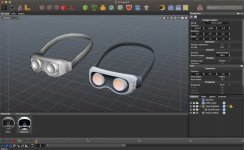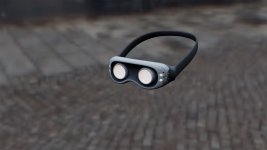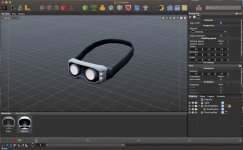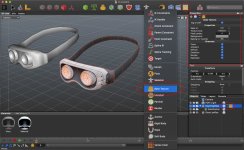You are using an out of date browser. It may not display this or other websites correctly.
You should upgrade or use an alternative browser.
You should upgrade or use an alternative browser.
how to bake textures from high mesh object to the lower mesh?
- Thread starter son of the light
- Start date
Do do you think you need a new UV layout? If you have one already it will work for additional subdivision levels. File from Cheetah3d help:
Left: base mesh, Right plus additional subdivision level 2:


Left: base mesh, Right plus additional subdivision level 2:
son of the light
Member
I don't understandDo do you think you need a new UV layout? If you have one already it will work for additional subdivision levels. File from Cheetah3d help:
Left: base mesh, Right plus additional subdivision level 2:
View attachment 38302View attachment 38304
What? Uv layout or adding a subdivision modifier and make it editable? From my point of view there´s no need for a new texture.
Oh wait - you have a high-res mesh in first place and want to reduce polycount?
son of the light
Member
I am working in 3D scan modo ,which is I need top a lower mesh from the high mesh ,then I need bake the diffuse and normals maps from the high meshOh wait - you have a high-res mesh in first place and want to reduce polycount?
ok - using "Simplify" in Cheetah3d will destroy the UV map which is kinda to be expected. You can generate new automatic UVs but these will not match the image texture. So I guess you need a more specialized software which can maintain UV islands and reduce polycount within these islands like Balancer. When you´re using procedural materials it doesn´t really matter and new automatic UVs should work.
Daemoc
0
You can bake textures from a highres mesh to itself then use those maps for the lowres model. It is easy enough to do, but I am at work at the moment. I won't be able to do an example for a while.
Note: you cannot bake normals for game content though. Only for static renders. With Cheetah there is no way to create normal maps where the object face normal = Z.
Note: you cannot bake normals for game content though. Only for static renders. With Cheetah there is no way to create normal maps where the object face normal = Z.
As I understand the image-textures (diffuse+normal) are already there and are no simple seamless tiling maps. I wonder how you are going to match these with a new low res model?
son of the light
Member
zremeshAs I understand the image-textures (diffuse+normal) are already there and are no simple seamless tiling maps. I wonder how you are going to match these with a new low res model?
son of the light
Member
can you teach how to do itYou can bake textures from a highres mesh to itself then use those maps for the lowres model. It is easy enough to do, but I am at work at the moment. I won't be able to do an example for a while.
Note: you cannot bake normals for game content though. Only for static renders. With Cheetah there is no way to create normal maps where the object face normal = Z.
Daemoc
0
@frank beckmann
I cannot see the source model he is using, but the high res source mesh and the low res mesh need to have the same UV layout. Most polygon reduction software is non destructive to the UV islands though. It also can be done by hand which is what I do most of the time, but my work flow is backwards. I build the low polygon game model first, then make the high polygon source from that.
@son of the light
I am not sure what you are using to create the low polygon model from the high res source, but I can show you what I do. It really is not that difficult as long as your two models have the same UV layout. You just bake the texture of the high res model to itself and use those texture maps on the low res model.
I will try to find a model I can use for a good example, but it may be a few days. My free time is pretty much nil at the moment.
If you are looking to bake textures from a model that does not have UV's or proper islands, you will not be able to do that in Cheetah. I think Blender has tools for that though.
I cannot see the source model he is using, but the high res source mesh and the low res mesh need to have the same UV layout. Most polygon reduction software is non destructive to the UV islands though. It also can be done by hand which is what I do most of the time, but my work flow is backwards. I build the low polygon game model first, then make the high polygon source from that.
@son of the light
I am not sure what you are using to create the low polygon model from the high res source, but I can show you what I do. It really is not that difficult as long as your two models have the same UV layout. You just bake the texture of the high res model to itself and use those texture maps on the low res model.
I will try to find a model I can use for a good example, but it may be a few days. My free time is pretty much nil at the moment.
If you are looking to bake textures from a model that does not have UV's or proper islands, you will not be able to do that in Cheetah. I think Blender has tools for that though.
Daemoc
0
Here is a real quick example...
1: Finished high res model and the low res mesh.

2: A render of the highness model using the default oldtown HDRI

3: The result of the high res model baked texture

4: A non lit viewport screen grab of the low res mesh using the baked texture.

5: Bake tag example and settings.

This is not the best example but it is all I have on hand at the moment. Hopefully it is enough to get you started anyway.
1: Finished high res model and the low res mesh.

2: A render of the highness model using the default oldtown HDRI

3: The result of the high res model baked texture

4: A non lit viewport screen grab of the low res mesh using the baked texture.

5: Bake tag example and settings.

This is not the best example but it is all I have on hand at the moment. Hopefully it is enough to get you started anyway.
son of the light
Member
thank you so much ! but I still not understandHere is a real quick example...
1: Finished high res model and the low res mesh.
View attachment 38307
2: A render of the highness model using the default oldtown HDRI
View attachment 38309
3: The result of the high res model baked texture
View attachment 38311
4: A non lit viewport screen grab of the low res mesh using the baked texture.
View attachment 38308
5: Bake tag example and settings.
View attachment 38310
This is not the best example but it is all I have on hand at the moment. Hopefully it is enough to get you started anyway.
@frank beckmann
I cannot see the source model he is using, but the high res source mesh and the low res mesh need to have the same UV layout. Most polygon reduction software is non destructive to the UV islands though. It also can be done by hand which is what I do most of the time, but my work flow is backwards. I build the low polygon game model first, then make the high polygon source from that.
@son of the light
I am not sure what you are using to create the low polygon model from the high res source, but I can show you what I do. It really is not that difficult as long as your two models have the same UV layout. You just bake the texture of the high res model to itself and use those texture maps on the low res model.
I will try to find a model I can use for a good example, but it may be a few days. My free time is pretty much nil at the moment.
If you are looking to bake textures from a model that does not have UV's or proper islands, you will not be able to do that in Cheetah. I think Blender has tools for that though.
He wrote "zremesh", and that remesher is a tool inside zbrush (I still do have my doubts about the legality of his software since he showed that chinese site with cracks in one of his posts; now that he is coming with zbrush even more).
Zbrush is the best sculpting app you can imagine, nothing else can handle that polycount without problems, but it certainly has (in my personal view) an absolutely horrible and unintuitive UI as well as some quirks. One of them is simply that it destroys existing uvs. There are work-arounds to keep them, but you really have to hop through loops to do it. I am not sure if it is possible to use zremesher in combination with that.
Doing it "by hand" would mean good old retopology with such an object, meaning, you'd loose the uv as well as with any other method I have at my hands.
@son of the light
I do not think that what you want is possible with the combination of Cheetah and Zbrush. Maybe it's faisible with zbrush alone, so please ask in their forum. Or you do use Blender or some specialized app for this.
Most of the time, with the simple photoscans I have seen, the image texture isn't that good anyway. So you could bake the normal map in zbrush which would give you a new uv map. You would have to recreate the material in Cheetah or whatever. By doing that you'd probably get way better results.
If it's just for a render, maybe you could use the scanned object as it is, depending on its resolution. I'm pretty sure, though, that the texture will not look that good.

